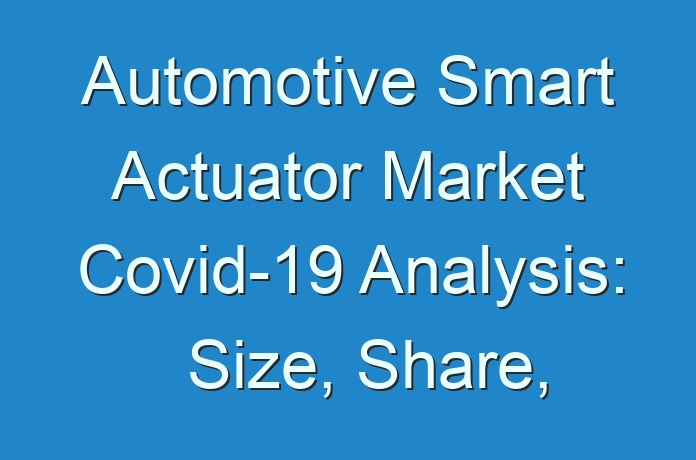
Automotive Smart Actuator Market: Introduction
Automotive smart actuators are innovative actuators, which work in synchronization with adjacent electronics and sensors to make dynamic adjustment to automotive systems. Automotive smart actuators have the ability to perform diagnostics and possess features of artificial intelligence, which include learning and memorizing things.
The automotive smart actuator market is likely to expand with the development of smart mobility and autonomous vehicles.
Automotive Smart Actuator Market: Competitive Landscape
Johnson Electric, NMB Technologies Corporation, Continental AG, Robert Bosch GmbH, Valeo S.A., Embitel, Rheinmetall Automotive AG, Cebi International S.A., and Mitsubishi Electric Corporation are key manufacturers of automotive smart actuators.
Johnson Electric
Established in 1959 and headquartered in Hong Kong, Johnson Electric has a wide product portfolio and provides solutions to a large number of industries, including automotive, building automation & security, business machines, aerospace & defense, food & beverages, home technologies, HVAC, industrial equipment, medical devices, personal care, power equipment, and power tools for electric components. It has more than 38,000 employees working across 23 countries.
To Understand How Our Report Can Bring Difference to Your Business Strategy, Ask for a Brochure https://www.transparencymarketresearch.com/sample/sample.php?flag=B&rep_id=73025
DENSO CORPORATION
DENSO CORPORATION was established in 1949 and is headquartered in Kariya, Aichi, Japan. The company operates through three major business segments: automotive, consumer products, and industrial products. Under the automotive segment, the company offers diverse products, including powertrain control systems, electronic systems, thermal systems, information & safety systems, and small motors. DENSO CORPORATION has over 171,992 employees across the globe.
Continental AG
Continental AG was established in 1871 and is headquartered in Hanover, Germany. Continental AG is a leading supplier of automotive components. The company operates through two major groups: automotive group and rubber group. These groups are further divided into various business verticals such as powertrain, chassis & safety, interior, tires, and services. The company has a global presence and operates through its offices in the Americas, Africa, Europe, and Middle East & Africa.
Robert Bosch GmbH
Robert Bosch GmbH was established in 1886 and is headquartered in Gerlingen, Germany. The company operates through four business segments: consumer goods (including household appliances and power tools), mobility (hardware and software), industrial technology (including drive and control), and energy and building technology. The company offers diverse products, including electric motor, brake shoes, lightings, and display systems under the mobility segment. The company manufactures various types of sensors and systems that enhance the safety of vehicles.
Valeo S.A.
Valeo S.A. was established in 1923 and is headquartered in Paris, France. Valeo S.A. is a leading supplier of automotive components. The company had over 113,600 employees in 2018. Valeo S.A. operates through more than 186 production units located across 33 countries worldwide. The company provides various solutions, such as driving assistance systems, powertrain systems, thermal systems, and visibility systems to the global automotive industry.
Automotive Smart Actuator Market: Dynamics
Development of Autonomous Vehicles
The automotive smart actuator market is anticipated to expand at a significant pace during the forecast period, owing to investments being made by major OEMs for the development of autonomous vehicles with focus on integration of intelligent components. Moreover, smart actuators reduce the number of components in a system as compared to a system equipped with conventional actuator, thus reducing the weight of the systems.
The development of smart mobility systems is anticipated to drive the automotive smart actuator market. Moreover, the expansion of electric vehicle market is projected to propel the market for automotive smart actuators, owing to the integration of a large number of electronic components in vehicles.
Expanding operations in future? To Get the Perfect Launch Ask for a Custom Report https://www.transparencymarketresearch.com/sample/sample.php?flag=CR&rep_id=73025
Evolution from Mechanical Actuation to Smart Actuation
Automotive smart actuators can be integrated in a large number of automotive systems, such as powertrain, turbocharger, door locks, active grill shutter, HVAC system, etc. Moreover, integration of technologies, such as voice controlled systems and gesture recognition systems is expected to be fuel the expansion of the automotive smart actuator market.
Global Automotive Smart Actuator Market: Segmentation
In terms of application, the global automotive smart actuator market can be segmented into:
- Powertrain
- HVAC System
- Security Systems (Vehicle Locking)
- Turbochargers
- Active Grille Shutter
- Adaptive Headlamps
- Others
Based on operation, the global automotive smart actuator market can be divided into:
- Manual
- Autonomous Vehicles
- Semi-autonomous Vehicles
On the basis of sales channel, the global automotive smart actuator market can be bifurcated into:
- OEM
- Aftermarket
Based on electric vehicle type, the global automotive smart actuator market is segregated into:
- Battery Electric Vehicle
- Plug-in Hybrid Electric Vehicle
- Hybrid Electric Vehicle
In terms of vehicle type, the global automotive smart actuator market can be classified into:
- Passenger Vehicle
- Light Commercial Vehicle
- Heavy Commercial Vehicle
The report on the global automotive smart actuator market is a compilation of first-hand information, qualitative and quantitative assessment by industry analysts, and inputs from industry experts and industry participants across the value chain. The report provides in-depth analysis of parent market trends, macroeconomic indicators, and governing factors, along with market attractiveness as per segments. The report also maps the qualitative impact of various factors on market segments and regions.





